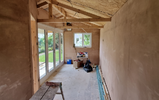I'm renovating a bedroom with original Victorian lath and plaster walls. Due to be reskimmed. I noticed a bodge in one corner - bulging pink gypsum patches covered in some kind of waterproofing paint - and pulled at them. Lo and behold, it's small rectangles of thin plasterboard, nailed into the original lath with short, very loose nails. The other side of this partition is a shower, which wasn't properly waterproofed: you can see cement board at the top (hurrah), but ordinary plasterboard at the bottom (what?!), which had just been gypsum skimmed to a shiny finish and then tiled over. lt moves or swelled, cracked the grout lines between tiles, and got soaked. So that shower needs redoing, with Hardie backer and tanking (floor to ceiling) this time. The whole bathroom will get a redo, while we're at it. Ditto the sodden ceiling below.
So, coming back to my bedroom, back on the other side of that partition wall:

I've removed the loose lime plaster. The rest of the wall has a bit of give/bounce, but not too bad. So: do I cut the plaster away a bit more, until I have a nice rectangular opening, pyt in some rot-proofed noggings, screw in moisture resistant plasterboard (properly fastened to the studs this time), make it all level with the surrounding plaster (either with gypsum, or lime plaster?), and then let the plasterer skim over the top of everything? Or do I go a bit more drastic, and redo the whole wall in plasterboard?
So, coming back to my bedroom, back on the other side of that partition wall:
I've removed the loose lime plaster. The rest of the wall has a bit of give/bounce, but not too bad. So: do I cut the plaster away a bit more, until I have a nice rectangular opening, pyt in some rot-proofed noggings, screw in moisture resistant plasterboard (properly fastened to the studs this time), make it all level with the surrounding plaster (either with gypsum, or lime plaster?), and then let the plasterer skim over the top of everything? Or do I go a bit more drastic, and redo the whole wall in plasterboard?



